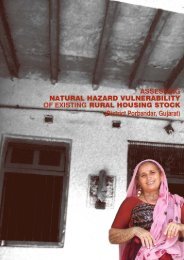Wastewater Irrigation in Gujarat - People in Centre Consulting
Wastewater Irrigation in Gujarat - People in Centre Consulting
Wastewater Irrigation in Gujarat - People in Centre Consulting
You also want an ePaper? Increase the reach of your titles
YUMPU automatically turns print PDFs into web optimized ePapers that Google loves.
shows that there is a high deficit of 84.5 MLD <strong>in</strong> the city, which is almost 47 percent<br />
short of the required capacity. The RMC plans to augment the treatment capacity by<br />
170.5 MLD <strong>in</strong> next three years by plann<strong>in</strong>g to set up STPs of 44.5, 70 and 56 MLD<br />
respectively. If achieved, then the city will have a surplus of treatment capacity by<br />
around 36 percent.<br />
Table 15: Sewage Treatment Scenario <strong>in</strong> Rajkot<br />
City Total Water Required<br />
supply (MLD) Treatment<br />
Capacity<br />
Sewage Available<br />
Treatment<br />
Capacity<br />
Rajkot 225 180 95.5 -84.5<br />
Source: Information from municipal officers <strong>in</strong> Rajkot city<br />
Deficit/Surplus<br />
As per the House list<strong>in</strong>g and Household data of Census 2011, Rajkot has 76.5<br />
percent households, which have access to close dra<strong>in</strong>s, 17.6 percent households <strong>in</strong><br />
the city have access to open dra<strong>in</strong>age and 6 percent households don’t have access<br />
to any dra<strong>in</strong>age. This implies that a maximum of wastewater generated by 90.2<br />
percent households would reach the sewage treatment plants <strong>in</strong> the city.<br />
<strong>Wastewater</strong> used for irrigation<br />
A detailed study was undertaken of surround<strong>in</strong>g areas of Rajkot city to understand<br />
the magnitude of wastewater used for irrigation. The table below provides the area<br />
under various crops for Rajkot based on the primary field surveys.<br />
Table 16: Area under Various Crops us<strong>in</strong>g <strong>Wastewater</strong> <strong>Irrigation</strong><br />
Crop Area <strong>in</strong> Per Hectare Water Total<br />
water<br />
hectares Requirement (<strong>in</strong> requirement (<strong>in</strong> million<br />
million litres) litres for a season)<br />
Alfa Alfa 676 10.55 7132<br />
BT Cotton 746 10.55 7870<br />
Castor 313 9.80 3067<br />
Groundnut 222 6.52 1449<br />
Juwar 926 6.42 5950<br />
Makai 352 4.45 1566<br />
Rose/Flower 107 10.44 1117<br />
Soyabean 88 3.00 264<br />
Vegetables 1418 23.75 33678<br />
Wheat 911 3.70 3371<br />
Total 5759 89.18 65464<br />
Source: Field study, 2012 and<br />
http://www.agri<strong>in</strong>fo.<strong>in</strong>/default.aspx?page=topic&superid=1&topicid=16, accessed on<br />
26 th October 2012<br />
The above table <strong>in</strong>dicates that 65,464 million litres of water is used annually for<br />
irrigation <strong>in</strong> Rajkot. Hence, the average use per day is around 179.3 MLD. The water<br />
supply <strong>in</strong> Rajkot is 225 MLD; therefore 80 percent wastewater gets generated, which<br />
32




